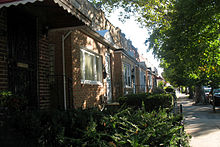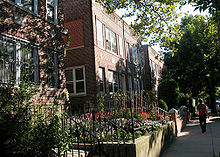- Norwood Gardens
-
Norwood Gardens is a planned community in Astoria, Queens. Developed in the 1920s during a period of expansion in New York City.
With the opening of the Queensboro Bridge in 1909 and the extension of the IRT subway service to Ditmars Boulevard in 1915, Astoria and Long Island City were forever changed from an outlying, difficult to reach suburb to a connected borough of New York City, just 15 minutes from Grand Central Station and the heart of New York City.
Sales brochures and pamphlets published in late 1920s by the Queens Chamber of Commerce advertised the Norwood Gardens homes as “Country Living In The City”.
The Norwood Garden homes offered affordable housing to both professional and working class families with the benefits of fresh air, green space and more spacious living quarters than a middle or working class family would find in a typical Manhattan apartment.
Norwood Gardens includes many two-family detached homes on 35th, 36th and 37th Street, a unique block of one family attached homes east side of 37th Street and thirty unique attached terrace homes on 36th Street. The 36th Street homes were popularly called Doctor’s Row due to doctors combining their practice offices under their living quarters.
Previously 36th Street was named Blackwell Avenue which was later changed to 7th Avenue and is now called 36th Street. In the 1920s up until the late 1970s the avenues either side of Norwood Gardens were called Jamaica Avenue (31st Avenue) and Grand Avenue (30th Avenue).
The 36th Street terrace homes were designed by Walter Hopkins, an architect with Warren & Wetmore. In the late 19th century – early 20th century, Warren and Wetmore was a prominent New York architectural firm, responsible for the design of Grand Central Station as well as other notable hotels and buildings.
The thirty attached terrace homes showcased 25’ front gardens planted with California privet hedges, over 22 kinds of evergreens, many 10’ – 12’ tall, as well as a large variety of flowering shrubs not typically seen in a metropolitan city.
The interior space of the terrace homes was designed to provide circulating, fresh air, sunlight and spacious living quarters.
The exterior design is a lively combination of white stucco and red tapestry brick, the mortar a bright white lime mixed with quartz aggregate that sparkled and accentuated the brick. Additional architectural elements include iron balconies, lattice work, green blinds, cement flower pots on the roof, red tile, planter supports in the shape of lambs heads and a variety of architectural medallions embedded in the brick.
Rickert-Brown Realty Company built the homes, bathroom fixtures were furnished by J. L. Mott Iron Works of Manhattan (J.L Mott for whom Mott Street in Chinatown was named after).
In 1929, Norwood Gardens homes sold for $15,000 (corner homes for $16,000) . The mortgages were underwritten by Metropolitan Life Insurance Company.
Twenty-nine of the thirty homes are nearly untouched since the 1920s.
Today
Largely unspoiled by development, the planned community of Norwood Gardens is still a low rise residential neighborhood. The green city trees and front gardens of 35th, 36th and 37th Streets create a special district in Astoria. Neighborhoods such as Norwood Gardens have been rapidly disappearing in the recent Queens development boom.
References
- "Norwood Gardens Colony". New York Times. July 2, 1922. http://query.nytimes.com/gst/abstract.html?res=9402E2DB1039E133A25751C0A9619C946395D6CF. Retrieved March 13, 2010.
- Rickert-Brown Co. Developments in Astoria, July 22, 1922, Queens Chamber of Commerce
- Queens Real Estate Market Active, Demand for Moderate-Priced Houses Still In Excess of the Supply, July 22, 1922, Queens Chamber of Commerce
Categories:- Planned communities in the United States
- Warren and Wetmore buildings
- Queens, New York City
- Metropolitan Life Insurance Company
Wikimedia Foundation. 2010.



